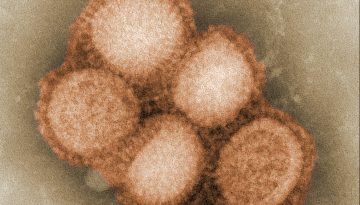 By Andy Hsu, Admin Team
By Andy Hsu, Admin Team
Viruses are small genetic bundles that hijack the metabolic processes of infected cells and can make us sick. One type of virus, called “enveloped viruses”, includes influenza, human immunodeficiency virus (HIV) and herpes simplex virus 1 (HSV-1). These invisible particles can pack a real punch; in 2018-2019 alone, influenza caused 3,657 hospitalizations, 613 ICU admissions and 224 deaths in Canada [1]. The Pryzdial Lab (Candian Blood Services; Centre for Blood Research) is studying how these viruses make us sick, and what we can do to combat this.

Digitally-colourized transmission electron microscopic (TEM) image of the H1N1 enveloped virus. Photo credit: CDC/ C. S. Goldsmith and A. Balish.
As the name implies, enveloped viruses are wrapped in a membrane or envelope. The virus uses different proteins in this membrane to bind to host cells which are required for infection. A previous study by Dr. Michael Sutherland and co-workers in the Pryzdial Lab demonstrated that several enveloped viruses incorporate host “tissue factor” (TF), a protein essential for blood clotting and cell signaling, into their membrane. They showed that this host-derived TF enhances viral infection of cells in vitro [2].
By preparing the model enveloped virus HSV-1 in a TF-inducible cell line, Sutherland et al. further elucidated the role of host TF in viral infection in vivo in a recent study [3]. HSV-1 that incorporated host TF was able to infect different organs (brain, lung, heart, spinal cord and liver) of mice, whereas HSV-1 lacking host TF in the envelope showed decreased infection of these organs. The authors found that anticoagulants – substances that dampen blood clot formation by interfering with TF-dependent pathways – prevented infection by TF-carrying HSV-1, i.e. these anticoagulants have antiviral activity.
Importantly, these results highlight the potential of targeting host TF on the virus as an antiviral therapeutic strategy. Furthermore, these findings suggest that it is worth investigating which proteins derived from different host cells are incorporated as effectors into viral envelopes. Identifying new envelope antiviral targets will provide novel avenues of research and promote the development of new antiviral drugs to prevent countless deaths and hospitalizations.
Maybe there will come a day when we won’t have to worry about enveloped viral infections!
- Government of Canada. FluWatch annual report: 2018-19 influenza season. canada.ca/en/public-health/services/publications/diseases-conditions/fluwatch/2018-2019/annual-report.html (accessed January 2020).
- Sutherland MR, Ruf W, Pryzdial ELG. Tissue factor and glyco-protein C on herpes simplex virus type 1 are protease-activated receptor 2 cofactors that enhance infection. Blood 2012; 119: 3638–45.
- Sutherland MR, Simon AY, Shanina I, Horwitz MS, Ruf W, Pryzdial ELG. Virus envelope tissue factor promotes infection in mice. J Thromb Haemost 2019; 17: 482–91.


